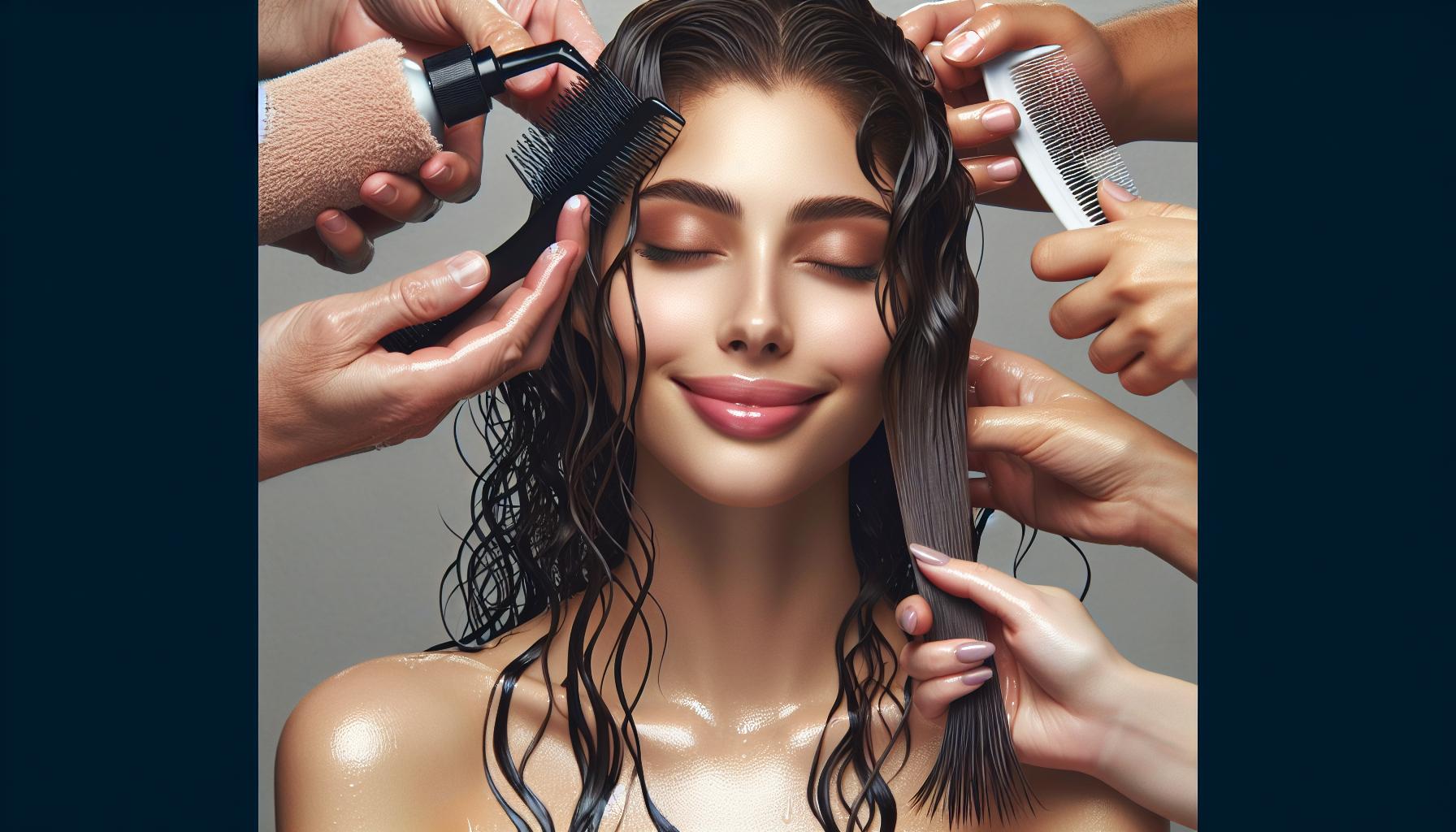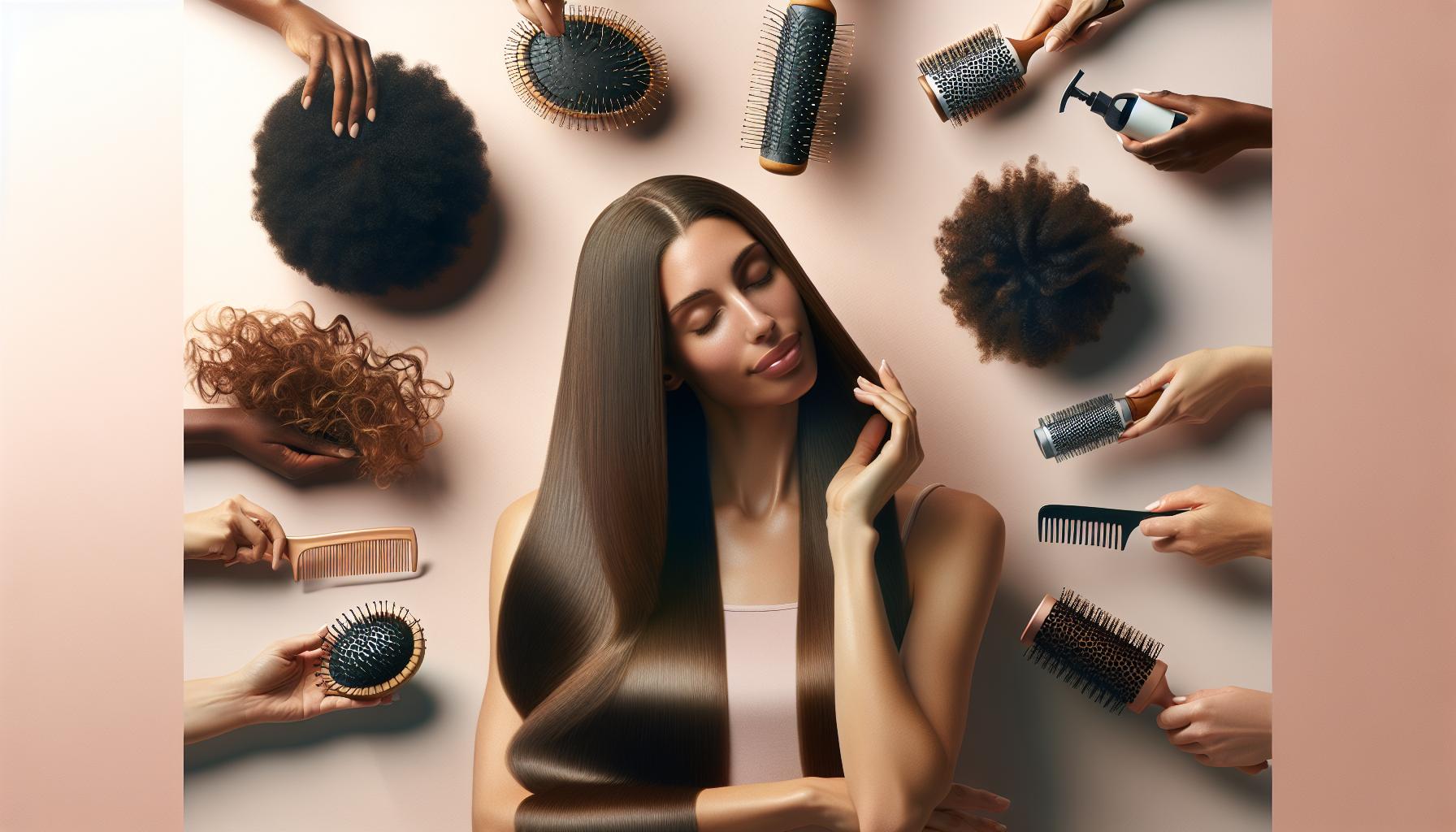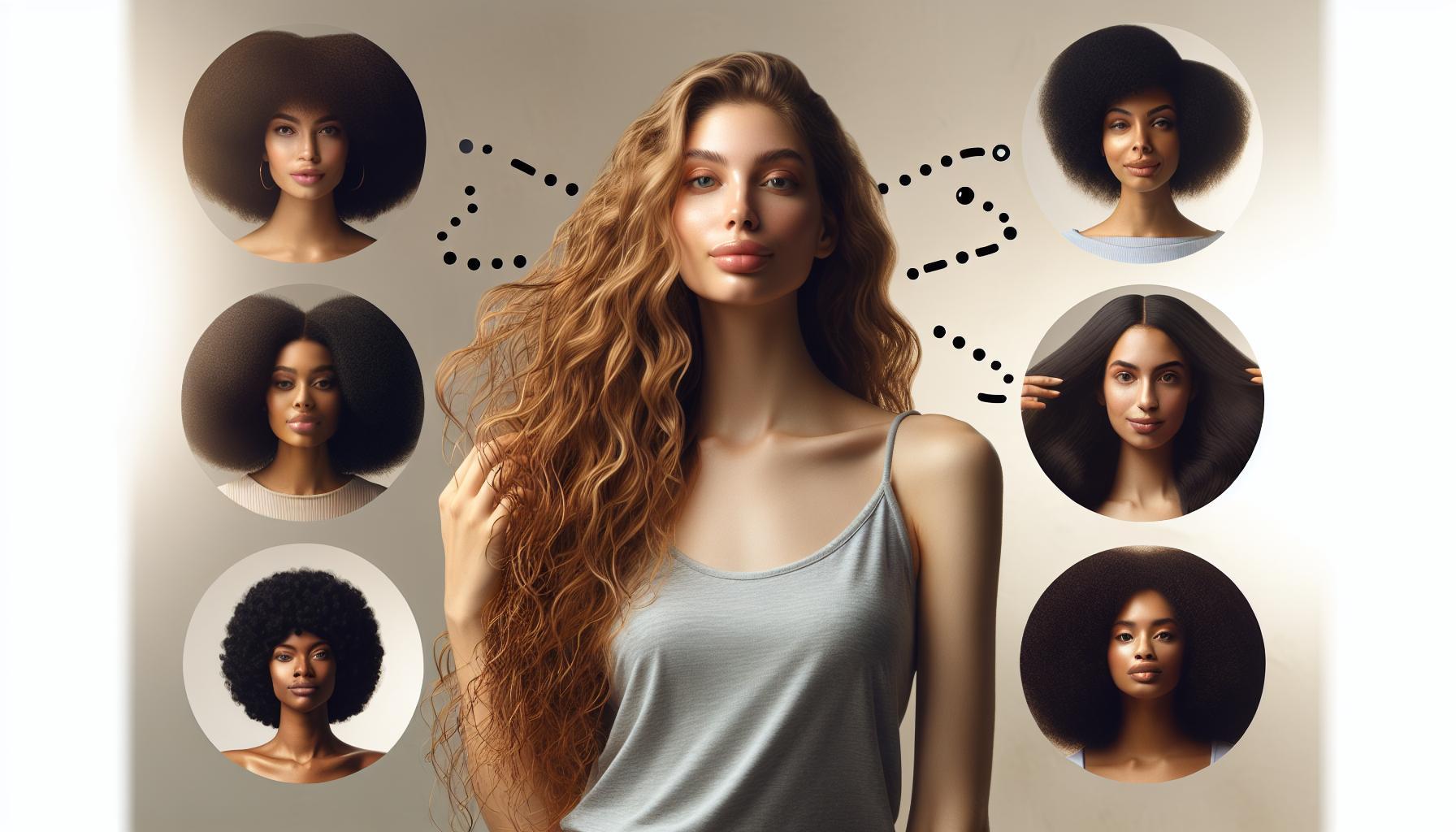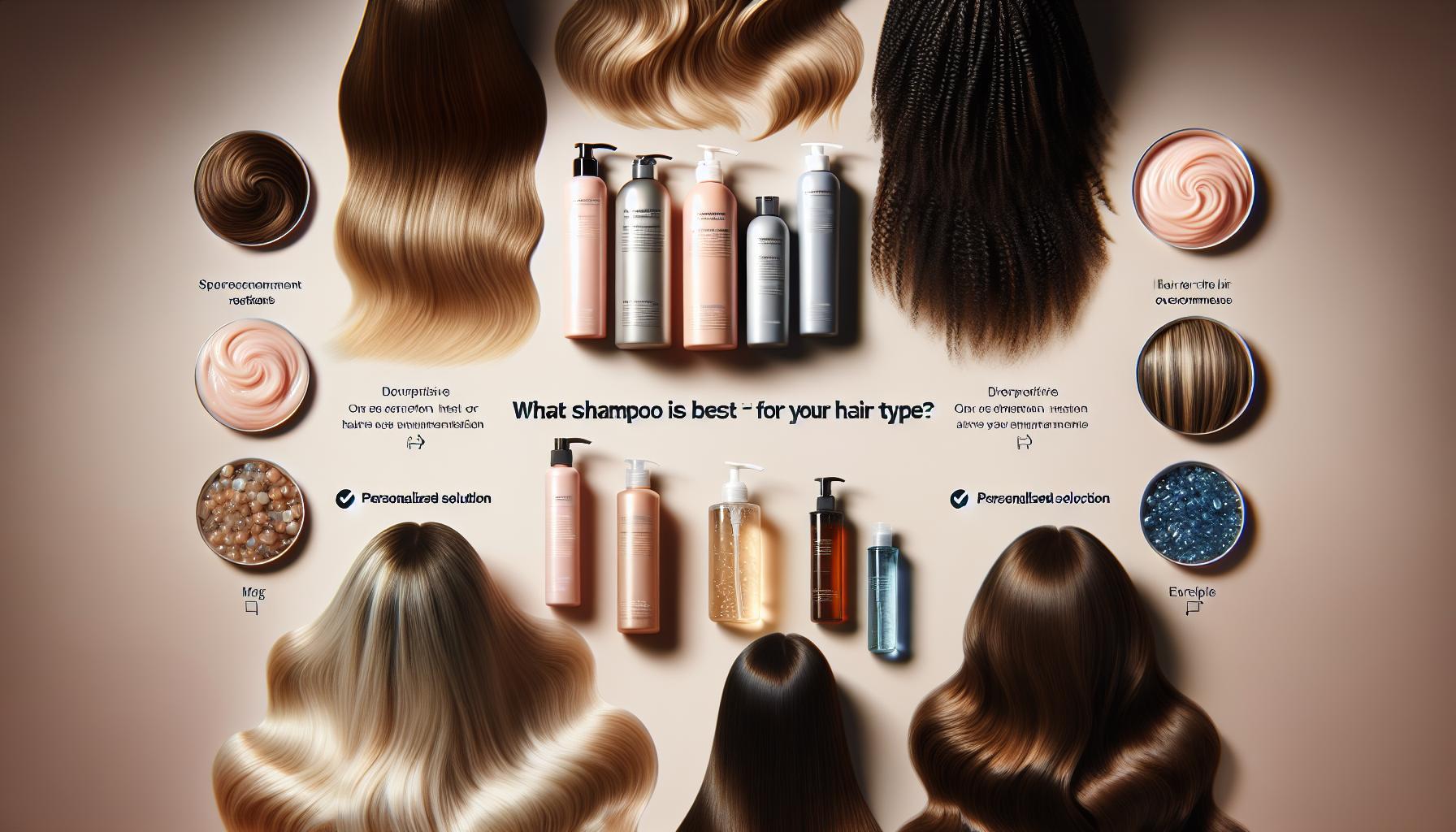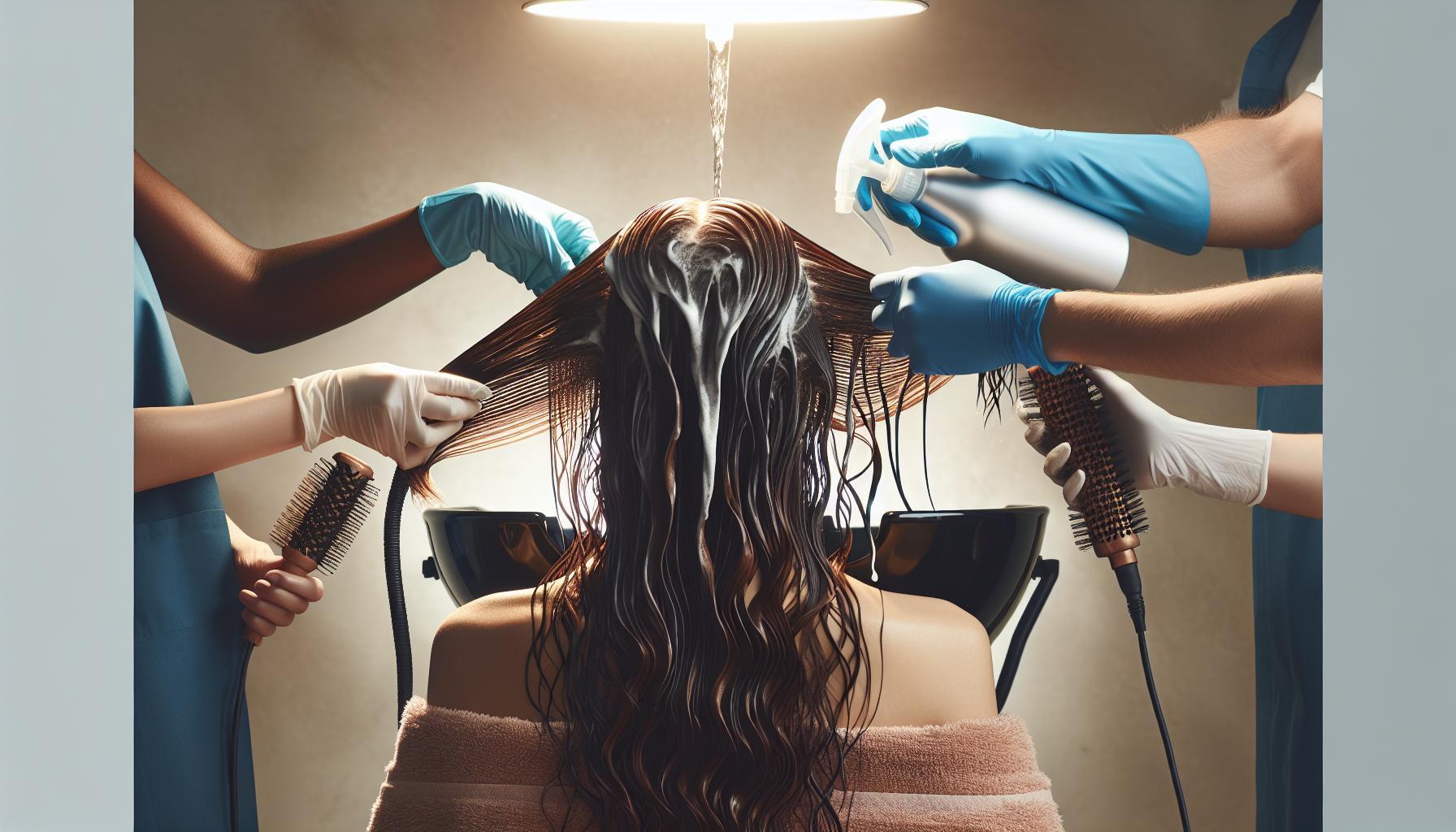Tying up wet hair may seem convenient, but it raises concerns about potential damage and breakage. Understanding how to manage damp locks without harming them is crucial for maintaining healthy hair. In this article, we share expert advice on safe techniques and products to keep your strands strong and stylish.
Contents
- Understanding the Impact of Wet Hair on Health and Texture
- expert Techniques for Safely Securing Wet Hair
- Choosing the Right Accessories: What to Use and What to Avoid
- The Science Behind Hair Elasticity: Why Wet Hair is More Vulnerable
- Prepping Your Hair for a protective Style: Essential Steps
- Quick Fixes: Emergency Solutions for Tying Up Wet Hair
- Daily Habits to Minimize Damage When Working with Wet Hair
- The Psychological Side of Hair Care: Feeling good About Your Choices
- FAQ
- Can you tie up wet hair without damaging it? Expert advice?
- Why does tying up wet hair cause damage?
- What is the best way to tie up wet hair?
- Can I use hair products on wet hair before tying it up?
- Why does my hair get tangled when it’s wet?
- How long should I wait to tie up my hair after washing it?
- Can tying up wet hair lead to hair loss?
- Insights and Conclusions
Understanding the Impact of Wet Hair on Health and Texture
When it comes to hair care, many people wonder about the effects of tying up wet hair. Did you know that wet hair is at its most vulnerable state? With a higher water content, strands lose their strength, making them prone to breakage. Understanding the impact of tying up damp hair is essential not only for maintaining your locks’ health but also for preserving their texture and appearance.
### The Effects of Moisture on Hair structure
When hair is wet, it undergoes several changes that affect its structure and resilience. The outer layer of the hair, known as the cuticle, becomes slightly loosened, which can lead to environmental pollutants and friction causing more damage. Here are some key points to consider:
- Increased Fragility: Wet hair can stretch up to 30% more than dry hair, making it more susceptible to breakage when pulled or tied.
- Swelling of the Hair Shaft: The hair shaft swells when wet,leading to a temporary increase in diameter. This can contribute to tangling if tied improperly.
- Cuticle Alignment: When hair is dry, cuticles lie flat, offering natural shine and protection. Wet hair’s cuticles are raised, which diminishes hair’s smooth appearance.
### Practical Tips for Managing Wet Hair
To manage your hair effectively without risking damage, especially after washing, consider these expert-recommended tips:
1. Gentle Handling
Always handle wet hair with care. Instead of rushing into tying it up, take a moment to detangle gently with a wide-toothed comb. This minimizes friction and breakage.
2. Choose the Right Hair Tie
Select a soft fabric hair tie or scrunchie that won’t tug at your hair. Here’s a speedy comparison of hair tie options:
| hair Tie Type | Damage Risk | Best Use |
|---|---|---|
| Scrunchies | Low | All hair types, especially wet |
| Elastic Bands | High | Dry hair use only |
| Plastic Hair Clips | Medium | Quick updos, caution with wet |
3. Opt for a Loose Style
If you must tie up your wet hair, maintain a loose style.This prevents excessive tension on any single area of your hair and gives your strands a chance to dry without being restrained.
Combining these techniques can considerably reduce the risks associated with tying up wet hair. Taking proactive steps ensures your hair maintains its health and texture while also answering the question, “Can you tie up wet hair without damaging it?”
expert Techniques for Safely Securing Wet Hair
tying up wet hair can ofen feel like walking a tightrope – balancing the need for convenience with the inherent risks of damage. Did you know that wet hair is significantly weaker than dry hair, making it more susceptible to breakage and split ends? If you’re wondering weather you can secure your hair without causing harm, you’re not alone. Fortunately, with the right techniques and care, it is possible to protect your hair while keeping it styled. Here are some expert-approved methods to safely tie up your wet hair.
Choose the Right Accessories
When it comes to securing damp locks, the type of hair accessory can make a critically important difference. Here are some essential tips:
- Use Soft Scrunchies: Opt for soft fabric scrunchies or hair ties made from gentle materials. Avoid elastics that can snag or pull, as these are more likely to cause breakage.
- Stay Away from Metal: Hair ties with metal clasps can create friction and lead to tearing. Seek out alternatives crafted entirely from fabric or silicone for a smoother hold.
- Consider Hair Clips: Large, sturdy clips can help gather wet hair without pulling. Thay’re especially useful for securing hair in a bun or a loose updo.
Perfect Your Tying Technique
How you tie up your hair can significantly impact its health. Here are some techniques that minimize damage:
- Loose Styles Are Key: Keeping styles loose ensures that you’re not putting undue stress on your hair follicles. A loose bun or a low ponytail can allow your hair to dry without restriction.
- Avoid tight Buns: While a tight bun may seem polished, it can create tension, leading to breakage. Instead, try wrapping your hair into a soft ballet bun or a messy top knot.
- Twists and Braids: These styles can help manage wet hair without the need for tightness. A loose side braid or twist can keep hair organized while it dries.
Timing Is Everything
Another essential point to consider is the timing of tying up your hair. wet hair is at its most vulnerable promptly after washing when it’s saturated.
- Lightly Towel-Dry: Before securing your wet hair, gently blot it with a microfiber towel. This technique reduces moisture without the needless aggression of conventional towels.
- Air-Drying First: If time permits, allow your hair to air-dry for about 10-15 minutes before tying it up. This slight reduction in moisture can make a considerable difference.
- Use Leave-In Conditioners: To protect against breakage, applying a leave-in conditioner can help provide a barrier against stress and hydration loss.
By implementing these expert techniques,you can confidently answer the question: can you tie up wet hair without damaging it? With thoughtful choices in accessories,a focus on gentle styling methods,and proper timing,your hair can stay healthy while you go about your day.
Choosing the Right Accessories: What to Use and What to Avoid
When it comes to managing wet hair, the right accessories can make a significant difference in maintaining hair health. Many people wonder, “Can you tie up wet hair without damaging it?” and the answer lies in choosing the appropriate tools. Using the wrong accessories can lead to needless breakage and stress on your strands, so it’s crucial to understand what works best.
Recommended Accessories for Wet hair
- Scrunchies: These soft hair ties are often made from fabric and are gentle on wet hair, minimizing tension and breakage. Their stretchable nature also helps accommodate hair as it dries.
- Clips: Optional when you want to secure hair in place without added stress,clips provide a no-crease hold. Look for those with padded or rounded edges to prevent slipping and pulling.
- Microfiber Hair Wraps: Ideal for drying, these wraps absorb moisture quickly and reduce frizz. Using one can allow you to control your hair without tight binding, thus promoting healthy hair practices.
Accessories to Avoid
While certain accessories can protect your hair, there are those that should be kept at bay to prevent damage.
- Elastic hair Ties: Regular rubber bands can cause snags and breakage, especially when your hair is wet and more vulnerable. It’s best to avoid these altogether.
- Tight Buns or Ponytails: Using a stronghold style on wet hair can lead to severe strain and potential hair loss. If you must tie your hair back, ensure it’s a loose style.
- heavy Metal Clips: These can weigh down wet hair and create unwanted tension. Opt for plastic or padded alternatives instead.
Quick Comparison Table
| Accessory Type | Recommended | Avoid |
|---|---|---|
| Scrunchies | ✔️ | ❌ |
| Clips | ✔️ | ❌ (heavy metal) |
| microfiber Hair Wraps | ✔️ | ❌ |
| Elastic Hair Ties | ❌ | ✔️ |
| Tight Buns/Ponytails | ❌ | ✔️ |
By considering these recommendations and avoiding harmful accessories, you can effectively answer the question, “Can you tie up wet hair without damaging it?” while ensuring your locks remain healthy and vibrant. Always remember that when your hair is wet, it needs special care, so choose your accessories wisely!
The Science Behind Hair Elasticity: Why Wet Hair is More Vulnerable
Understanding the delicate balance of moisture in your hair can significantly influence its strength and health,especially when it comes to styling.Wet hair often appears lustrous and full, but underneath that shiny surface lies a vulnerability due to its unique structure. When hair is wet, its elasticity increases, allowing it to stretch more than normal. This property can be both a benefit and a cause for concern, particularly if you’re considering tying it up.
Hair Structure and Wet Conditions
hair is primarily composed of a protein called keratin, which makes it strong and resilient.When hair is wet, the water molecules penetrate the hair shaft, disrupting the bonds between the keratin fibers. This disruption momentarily alters the hair’s natural configuration, leading to increased versatility—hence, the higher elasticity. Though, while this allows for easier manipulation, it also means that the hair is more prone to breakage and damage when subjected to tension or strain.
- Increased Elasticity: Wet hair can stretch up to 30% more than dry hair.
- Disrupted Bonds: Water breaks down hydrogen bonds in hair, weakening its structural integrity.
- Vulnerability to Damage: Tight hairstyles can lead to breakage and split ends when applied to wet strands.
practical Tips for Managing Wet Hair
If you’re wondering, “Can you tie up wet hair without damaging it?” the answer largely depends on how you approach it. Here are a few strategies to help prevent damage:
- looser Styles: Opt for loose ponytails or buns that do not put excessive tension on the hair.
- Use Gentle Accessories: Soft scrunchies or cloth hair ties can minimize friction and strain.
- Avoid Heat: Steer clear of heat styling tools on wet hair, as the combination can lead to severe breakage.
By following these tips and understanding the science behind hair elasticity, you can maintain the integrity of your locks while enjoying versatile hairstyles, even when your hair is damp.
Prepping Your Hair for a protective Style: Essential Steps
To maintain healthy hair while transitioning into a protective style, it’s crucial to prep adequately. Just like you wouldn’t start a journey without ensuring your vehicle is in good condition, your hair deserves the same level of attention. Proper readiness can significantly bolster the longevity of your style while protecting your strands from potential damage, especially if you’ve wondered, “Can you tie up wet hair without damaging it? Expert advice” suggests a meticulous approach to achieve the best results.
Assess Your Hair’s Health
before you consider styling, it’s essential to assess the current state of your hair.Look for signs of damage such as split ends, excessive dryness, or breakage. Incorporating a deep conditioning treatment into your routine can rejuvenate tired locks, making them more resilient to manipulation. aim for a deep condition at least a day before engaging in any protective styling, allowing the moisture to penetrate thoroughly.
Cleanse and Moisturize
A clean scalp is basic for protecting your hair.begin with a gentle cleansing shampoo to remove any buildup, followed by a hydrating conditioner.After cleansing, generously apply a leave-in conditioner or a light cream to ensure your hair stays moisturized.
- Preferred Products:
– Sulfate-free shampoos
– Hydrating conditioners
– Leave-in conditioners with natural oils
Keep in mind that moisture is vital, especially if you are considering styling your wet hair. If you’ve ever asked, “can you tie up wet hair without damaging it?” our expert advice emphasizes caution. Tying wet hair can lead to breakage if not handled correctly, so always ensure that your products are working to keep your hair hydrated yet manageable.
Protect and Style
once your hair is clean,conditioned,and adequately moisturized,it’s time to protect it. Before tying up your hair, consider the following:
- Use a Silk or Satin Scarf: This reduces friction that can cause breakage during the styling process.
- Opt for Soft Hair Ties: Avoid rubber bands or tight elastics which can snap your strands. Rather, use scrunchies or fabric-covered bands to create a gentle hold.
It is indeed advisable to do a loose tie on slightly damp hair rather of soaking wet hair. this reduces the risk of stretching your strands too much, which can lead to damage. A protective style that allows your hair to breathe—like loose braids or twists—can help preserve your hair health while you enjoy your new look.
By following these essential steps, you can ensure that your hair is primed for whatever protective style you choose, keeping it as healthy as possible even when you might wonder about tying up wet hair without causing damage.Your preparation sets the foundation for the look you desire while safeguarding the integrity of your stunning locks.
Quick Fixes: Emergency Solutions for Tying Up Wet Hair
When the clouds roll in and rain catches you by surprise, or when you just can’t find the time to dry your hair before heading out, the question arises: how can you securely tie up your wet hair without causing damage? The good news is that there are quick and effective solutions designed to protect your strands while keeping you looking stylish. Implementing some expert-approved techniques can ensure that your hair stays healthy and manageable, even when it’s damp.
Choose the Right Tools
Using the right tools is vital when dealing with wet hair. Heavy-duty hair ties can cause breakage when used on damp strands, so consider alternatives that are gentler:
- Scrunchies: These soft, fabric-covered elastics are kinder to your hair and reduce pulling.
- Hair Clips: Large clips can hold wet hair without putting too much tension on strands.
- Fabric Bands: Opt for hair ties made from soft materials that won’t snag or pull at wet hair.
Avoid thin rubber bands as they tend to grip too tightly and can lead to fractures in your hair’s structure.
Techniques That Help
If you must tie up your wet hair,how you do it can make all the difference. Here are a few techniques that can minimize potential damage:
- The Loose Bun: Gather your wet hair into a loose bun at the nape of your neck. This helps avoid tension on the roots and allows moisture to evaporate more freely.
- The Half-Up, Half-Down Style: Pull the top half of your hair up and secure it with a scrunchie. Let the rest fall naturally to avoid excess heat and breakage.
- Pineapple Method: For curly hair, flip your head upside-down and loosely tie your hair at the top of your head. This protects definition and keeps strands from becoming frizzy.
These techniques leverage the natural properties of wet hair while retaining its health.
consider a Quick Drying method
If you’re battling the clock and feel the need to prevent frizz,here’s a quick drying method to ease tension on your hair before you tie it up:
| Step | Description |
|---|---|
| 1 | Apply a Leave-In Conditioner: This not only helps in detangling wet hair but also adds a critical layer of protection. |
| 2 | Blot, Don’t Rub: Use a microfiber towel to gently blot excess moisture from your hair.Rubbing can lead to frizz and breakage. |
| 3 | embrace the Air Dry: If time allows, let your hair air-dry for a few minutes before tying it up to minimize damage. |
In essence, by adopting the right tools and techniques, you can confidently answer the question of whether you can tie up wet hair without damaging it. With expert advice at your disposal,you can style your way through those wet hair emergencies effortlessly.
Daily Habits to Minimize Damage When Working with Wet Hair
When it comes to hair care, many people underestimate the vulnerability of wet hair. After washing, your strands are in a delicate state, making them more susceptible to breakage and damage. Understanding how to protect your hair while tying it up can make a significant difference.Here are some daily habits that can help minimize damage when you’re tempted to secure wet hair.
Choose the Right Accessories
Opting for the right hair accessories is crucial when managing wet hair. Rather of traditional hair ties, consider these alternatives:
- Soft Scrunchies: Made from soft materials, scrunchies are gentler on wet hair, reducing the risk of breakage.
- claw clips: These can hold hair without pulling,offering a safer option for securing damp locks.
- Spiral Hair Ties: Their design helps distribute pressure evenly, making them a smart choice for minimal stress on strands.
Adopt a Gentle Drying Routine
The way you dry your hair can significantly impact its health. Instead of vigorous towel drying, switch to these gentler methods:
- Microfiber Towels: Use a microfiber towel to gently blot moisture away. This fabric is designed to absorb water without friction that can cause damage.
- Air Drying Techniques: Allow your hair to air dry as much as possible before tying it back. This gives your strands time to strengthen naturally.
Mind Your styling Products
Incorporating the right products into your routine can further protect your hair. Choose lightweight,leave-in conditioners or detangling sprays specifically formulated for wet hair. Not only do these products provide added hydration, but they also create a protective layer against environmental stressors.
| Product Type | Benefits |
|---|---|
| Leave-in Conditioner | Hydrates and protects strands from breakage. |
| Detangling spray | facilitates easy combing and reduces snagging. |
by integrating these daily habits into your routine, you’ll not only be answering the question of whether you can tie up wet hair without damaging it but also actively promoting healthier hair in the long run. remember, the gentler you can be while managing wet hair, the more resilient your locks will become.
The Psychological Side of Hair Care: Feeling good About Your Choices
When it comes to hair care, the choices we make can significantly impact not only the health of our tresses but also our overall emotional well-being. Studies have shown that hair is often associated with identity and self-expression, making hair care a deeply psychological experiance. It’s not just about what products you use or what techniques you adopt, such as if you can tie up wet hair without damaging it; it also touches on feelings of empowerment and confidence.
The Connection between Hair Care and Self-Esteem
Our hair can often reflect our inner state. For many, well-cared-for hair can boost self-esteem and contribute to a positive self-image.Conversely, damaged or unruly hair can lead to feelings of insecurity. the decision to engage in good hair care practices—whether that means avoiding tying up wet hair too tight or choosing the right products—can empower individuals to feel more in control of their appearance. It’s crucial to make informed choices that align with your lifestyle, so you feel confident in your daily grooming routine.
To truly enhance your hair care experience from a psychological perspective, consider adopting a mindful approach. This could involve:
- Choosing Products Thoughtfully: Select products that cater to your specific hair type and concerns. Knowing you’re using the best options available boosts confidence in your routine.
- Practicing Gentle Techniques: Understanding how to tie up wet hair without damaging it is indeed essential. Opt for loose styles and avoid tight grips to maintain healthy hair.
- Embracing Routine: Establishing a hair care routine can create a sense of normalcy and control, providing a calming effect in a hectic world.
creating Lasting Psychological Comfort
The impact of hair care extends beyond physical appearance. It can forge a sense of community and individuality, offering a platform for self-expression. Emphasizing this, you might incorporate social practices, such as sharing hair care tips with friends or joining online communities focused on hair health.
For those concerned about specific practices—like whether tying up wet hair leads to long-term damage—look towards expert advice that encourages careful techniques. Additionally, consider this simple table summarizing expert recommendations on hair management:
| Technique | Benefits |
|---|---|
| Loose Buns or Braids | Reduces tension, prevents breakage |
| Microfiber Towel Drying | Minimizes frizz, absorbs moisture without heat |
| Regular Trims | Maintains health, reduces split ends |
The psychological benefits of thoughtful hair care choices are clear: they cultivate a stronger sense of self and boost emotional resilience. By understanding how techniques,like tying up wet hair,can affect not just hair health but personal confidence,individuals can begin to take charge of their grooming process,ultimately leading to more empowered daily choices.
FAQ
Can you tie up wet hair without damaging it? Expert advice?
Yes, you can tie up wet hair without causing damage, but proper techniques are essential. Using soft hair ties, avoiding tight styles, and ensuring your hair is not excessively wet can definitely help preserve its health.
When your hair is wet,it is at its most vulnerable. To minimize damage, opt for loose hairstyles like a low ponytail or a loose braid. Additionally, using a microfiber towel to gently pat your hair dry can reduce friction and enhance hair health.
Why does tying up wet hair cause damage?
Tying up wet hair can cause damage as wet hair is more prone to breakage and stretching. The hair shafts swell when wet, making them less elastic and more susceptible to tearing.
The tension from a tight hairstyle can lead to mechanical damage. This is why it’s crucial to use soft elastics and keep styles loose. For more information on hair care routines, check out our article on [caring for wet hair](#).
What is the best way to tie up wet hair?
The best way to tie up wet hair is by using a soft hair tie and creating a loose style, like a soft bun or a low ponytail. Always ensure the hair is patted dry before tying.
To provide extra care, try a scrunchie rather of a regular elastic as it causes less friction. Remember, the goal is to avoid unnecessary stress on wet strands, keeping your hairstyle low-maintenance and gentle.
Can I use hair products on wet hair before tying it up?
Yes, using hair products on wet hair can be beneficial. Lightweight leave-in conditioners or hair oils can help hydrate and protect your strands before styling.
However, avoid heavy products that could cause buildup or make your hair slippery and hard to manage. Always choose products designed for wet hair to maintain softness and prevent damage.
Why does my hair get tangled when it’s wet?
Hair tends to tangle more when wet due to its increased elasticity. The cuticle, or outside layer of the hair, lifts when wet, making tangles more likely.
Using a wide-tooth comb starting from the ends can help minimize damage. Consider incorporating a detangling spray for extra slip, which can prevent breakage as you style.
How long should I wait to tie up my hair after washing it?
It’s best to wait until your hair is damp rather than soaking wet before tying it up. This usually takes about 10-15 minutes after washing.
Make sure your hair is not dripping, as this reduces the risk of stress on your strands. Gently towel-drying can expedite this process while protecting the hair’s integrity.
Can tying up wet hair lead to hair loss?
Tying up wet hair doesn’t directly cause hair loss, but it can contribute to conditions like traction alopecia if done excessively or too tightly.
It’s crucial to practice gentle styling methods especially when your hair is wet. Opt for loose styles and regular breaks to allow your hair to recover.
Insights and Conclusions
while tying up wet hair can be convenient, it’s essential to proceed with caution to avoid potential damage.Hair is most vulnerable when wet, making it more prone to breakage and split ends if not handled carefully. To minimize risk, consider using a soft scrunchie or a specialized hair tie that reduces tension and friction. Additionally, incorporating leave-in conditioners can help fortify strands against the stress of being tied up. By following these expert recommendations,you can keep your hair healthy while enjoying the practical benefits of styling wet locks. For more tips and personalized advice,don’t hesitate to explore further and engage with our community of hair care enthusiasts. Your journey to healthier hair begins here!



